Gluten-free flours are a vital ingredient in the kitchens of those who follow a gluten-free diet due to celiac disease, gluten intolerance, or personal preference. With so many types of gluten-free flour available, it can be overwhelming to choose the right one for your recipe.
Today, we'll look at the different types of gluten-free flour and when to use them.
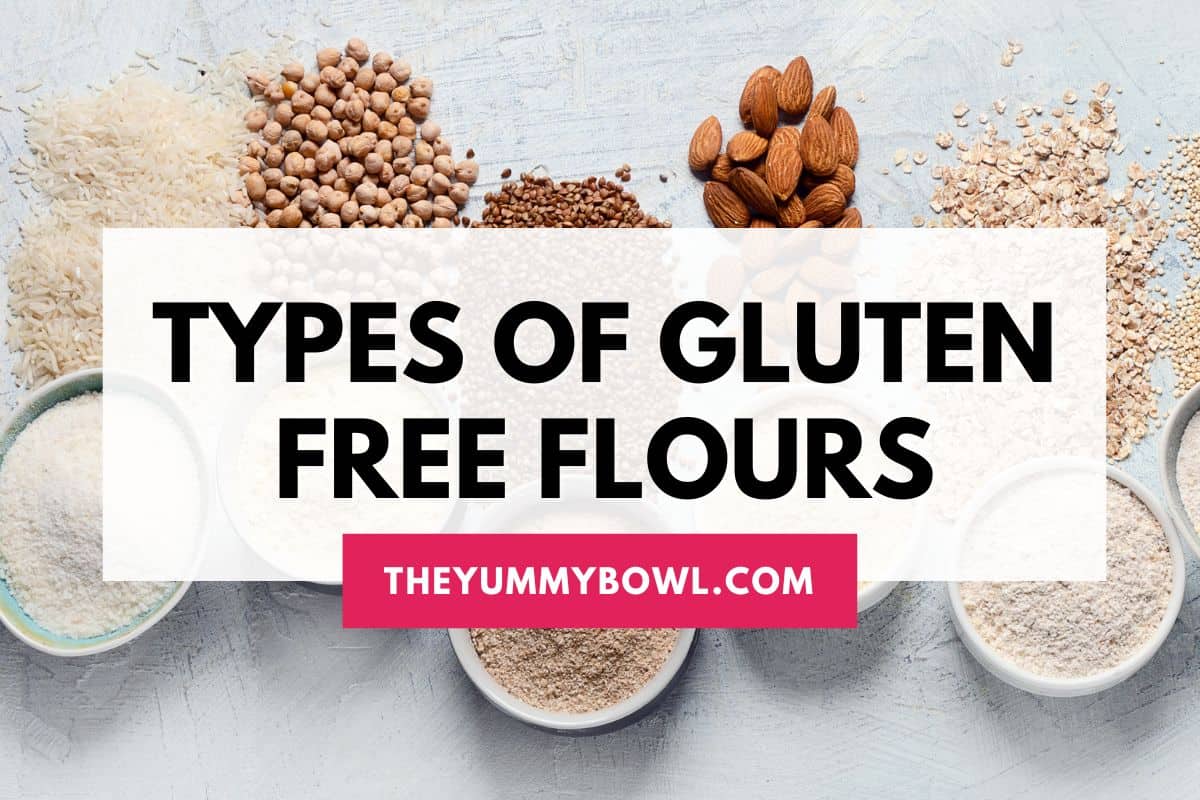
Jump To
- Why Are There Different Types of Flour for Gluten-Free Baking?
- Types of Gluten-Free Flour
- Almond Flour
- Is Almond Flour And Almond Meal The Same?
- Rice Flour
- Buckwheat Flour
- Sorghum Flour
- Corn Flour
- Chickpea Flour
- Teff Flour
- Coconut Flour
- Cassava Flour
- Gluten Free Oat Flour
- Oat Flour Recipes
- Amaranth Flour
- Quinoa Flour
- Millet Flour
- Bean Flour
- Tapioca Flour (Starch)
- Arrowroot Flour (Starch)
- Bleached Versus Unbleached Flour: What’s the Difference?
- Gluten-Free Flour Blends: What Is It and When Is It Used?
- Popular Brands of Gluten-Free Flour
- Gluten-Free Baking Tips and Tricks
- Gluten-Free Flour Conversions
- Gluten-Free Baking Recipes
- Are Gluten-Free Flours Considered Healthy?
- Recap
- FAQs
- You may also like
- Comments
Why Are There Different Types of Flour for Gluten-Free Baking?
There are different types of flour for gluten-free baking because different flours have different properties, and flavors and perform differently in various recipes. For example, some flours are lighter and more neutral, while others are denser and have a stronger flavor.
Gluten-free flours are quite different from regular flour, as they don't have the thickening aspect, emulsifiers, and stabilizers that prevent ingredients from separating.
However, most big-brand gluten-free flour blends do have some sort of thickening agent already built in their recipes.
The texture, moisture content, and protein levels of each flour can also affect the final product. Using the right gluten-free flour can help ensure that baked goods have the right texture, flavor, and structure.
That is why in baking we combine different gluten-free flours together to get the best results, very rare these flours listed here below are used alone in a baking recipe. Except for almond and oat flour - these flours make great pancakes without any difficult additions.
Some flours, such as almond flour, are naturally gluten-free, while others, like rice flour, are made from gluten-free grains.
By using a combination of different gluten-free flours in a recipe, you can achieve the desired taste and texture while avoiding gluten.
Types of Gluten-Free Flour
Here you'll find some popular gluten-free flours that can be found in most households when you are gluten-free.
Each and every one of them has different properties and produces very different results. Read on!
Almond Flour
Almond flour is made from ground almonds and has a nutty flavor. It is one of the most popular gluten-free flours is packed with nutrients, and is high in protein and healthy fats.
Almond flour is ideal for baked goods meant to be dense and moist, such as cakes and muffins, and especially recipes that require a dense pie crust. It has a specific taste - ultra nutty and with a moist texture as it is made purely from almonds.
It can also be used as an alternative to breadcrumbs for coating meat, fish, and veggies (zucchini fries and cauliflower bites) or as a thickener in sauces and soups.
When using almond flour, it is important to note that it absorbs more liquid than wheat flour, so the wet ingredients will need to be adjusted.
Almond flour is one of the most popular nut flours used but don't be limited and try alternatives like hazelnut, pecan, macadamia, and cashew flours.
Just like with almond flour, making them homemade is cheaper than buying them.

Is Almond Flour And Almond Meal The Same?
They are basically the same thing! The difference is that almond meal is typically made from raw (unpeeled) almonds, and almond flour is made from blanched (peeled) almonds.
Compared to almond meal, almond flour has a finer texture and lighter color.
They both can be used interchangeably in recipes that call for almond flour or meal but the texture will slightly be different.
Almond meal will result in a little more grainy consistency whereas almond flour will yield smoother results. These peanut cookies will taste great with both.
Rice Flour
Rice flour is made from ground rice and is a staple in many gluten-free kitchens. It is light in color and flavor and has a slightly grainy texture.
Rice flour is especially great for breads, pie crusts, and pizza dough.
Because rice flour is lighter than wheat flour, it is not recommended for dense liquid and high-fat baked goods like quick breads, cookies, and rolls.
You can use both brown rice and white rice flour, they are very similar with brown rice tasting more nutty and with higher nutritional value.

Buckwheat Flour
Buckwheat flour is made from the protein-rich seeds of the buckwheat plant and has a distinct, nutty flavor.
Despite the name, it has nothing to do with the wheat! Buckwheat is high in protein and fiber and has a smooth brown-grey color.
One of my favorite ways to use it is to thicken the sauces and curries. Thanks to its moist texture this flour is fantastic for pancakes, waffles, and crepes.
Sorghum Flour
Sorghum flour is made from ground sorghum and has a mild, slightly sweet flavor. It is high in fiber and protein and is naturally gluten-free.
Sorghum flour can be used in various baked goods, including bread, muffins, and cookies. It is also a great thickener for sauces and soups.

Corn Flour
Corn flour is made from ground corn and has a mild, slightly sweet flavor. It is naturally gluten-free and is often used in Mexican and South American cuisine.
Corn flour is great for making tortillas, tamales, and cornbread and can also be used as a coating for fried foods (try this crispy tofu).

Chickpea Flour
Chickpea flour, also known as garbanzo bean flour, is made from ground chickpeas and has a nutty, slightly earthy flavor.
It is high in protein and fiber and is naturally gluten-free. Read on about chickpea flour benefits in this Healthline article.
Chickpea flour can be used as a natural thickener for sauces, soups, stews, and curries (buckwheat flour is also fantastic for this), and may be used in baked goods as well combined with another GF flour type.
However, just remember that with any recipe you'll have to tweak the moisture content as chickpea flour is highly absorbent and has a sticky texture.
Teff Flour
Teff flour is made from ground teff, a tiny grain that is naturally gluten-free. It has a slightly sweet, nutty flavor and is high in fiber and protein.
Teff flour is commonly used in Ethiopian cuisines, such as injera, a sourdough flatbread, and can also be used in pancakes, waffles, and muffins.
It works better if combined with other GF flours like almond flour and buckwheat flour.
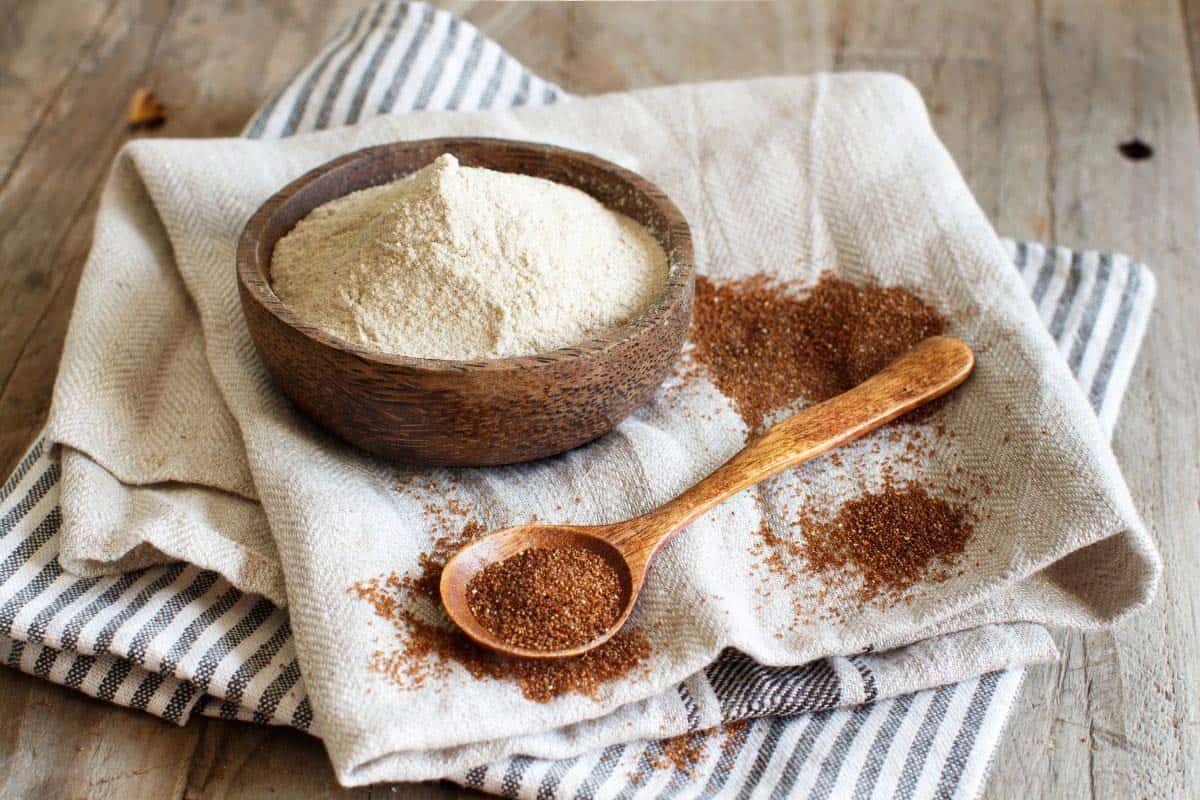
Coconut Flour
Coconut flour is made from ground coconut and has a slightly sweet flavor. It is low in carbs and high in dietary fiber, healthy fats, and protein.
Coconut flour is ideal for baked goods meant to be dense and moist, such as cakes.
However, you have to be careful with measuring, as this flour is highly absorbent and porous. The flour itself is slightly gritty so it is always best idea to sift it before use.
I usually use it in combination with other flour or flours.
Cassava Flour
What is it? Cassava is a root vegetable. This is a vegetable that is rich in carbohydrates and contains important vitamins and minerals.
To make cassava flour, the plant is first grated, dried and ground into fine powder. It is similar to tapioca starch flour - both are produced from the same cassava root but from different parts of it.
It is popular not only in baking goods but also for thickening sauces, flatbreads, tortillas, and pasta.
This flour has become popular replacing wheat flour in many recipes but I don't recommend using it a 1:1 ratio as this flour is denser and more absorbent than other GF flours.
Gluten Free Oat Flour
Made from oats that are ground into very fine powder.
Oats are naturally gluten-free: but it only applies to pure, uncontaminated oats that are produced in separate facilities from wheat products.
When shopping for oat flour, be sure to look for the certified gluten-free label.
And the best part is that you can make your own oat flour easily at home.
Put whole oats or quick oats into a food processor, blender, or spice grinder and pulse until you get a very fine powder.
You'll get pretty great results this way but never the same as using special equipment (grain mill), which is totally fine too.
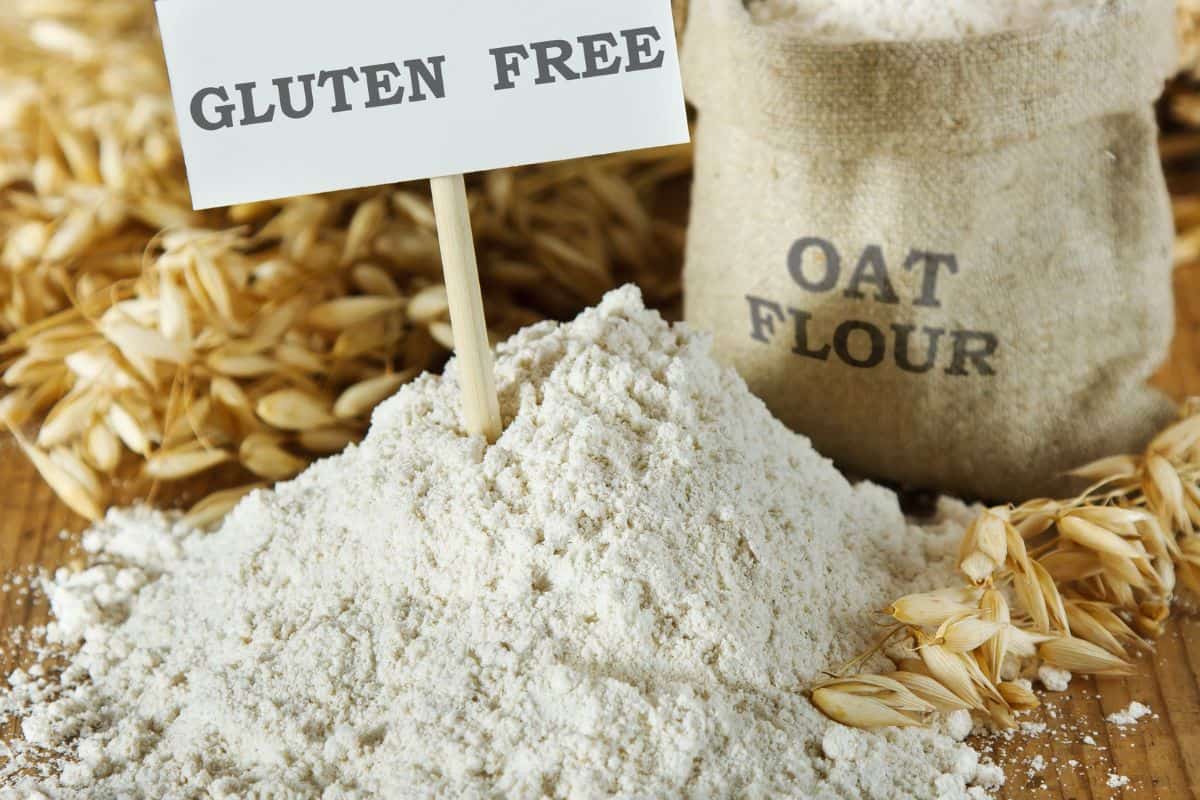
Oat flour has no distinct oat flavor adding chewier and crumblier texture to baked goods.
Oat flour is great for recipes like brownies, cookies, and cakes because it will add perfect moisture and chewiness to your recipe.
Amaranth Flour
Amaranth flour, despite not being a true cereal grain, is a gluten-free and highly nutritious flour derived from the seeds of the amaranth plant.
Its culinary versatility often leads it to be categorized alongside traditional grains.
Amaranth flour has a distinct nutty and earthy taste profile and sometimes can be quite strong.
From my experience, particularly in baking, it is best to start with small amounts and replace the rest with almond flour and something lighter like tapioca or arrowroot flour.
You can also use amaranth flour as a thickener for soups and stews.
Quinoa Flour
Quinoa flour is a gluten-free flour made from ground quinoa seeds. It has been cultivated for thousands of years.
Quinoa, often hailed as a superfood, is a grain-like seed known for its exceptional nutritional value.
Quinoa flour has a mildly nutty and earthly grassy flavor, which can be great to balance off some sweetness from other ingredients.
When used in baking, it provides a slightly denser texture compared to all-purpose wheat flour.
On its own, it can taste slightly bitter, so it is best if you combine it with other flours such as oat, rice, or tapioca flours.
Millet Flour
Millet is made by grinding up small seeds. These small-seed grasses have been a cereal crop staple for ages, grown in different corners of the globe, like Africa, Asia, and some parts of the US.
Millet has a mild and slightly sweet flavor and adds a crisp texture to the recipe.
But here's the kicker – for some baked goods, you might want to bring in a binding agent or mix it up with other gluten-free flours to nail that perfect outcome.
Bean Flour
Bean flour, made from ground dried beans like chickpeas, black beans, and navy beans, varies in flavor and texture based on the bean type.
While commercial bean flours are often expensive, you can grind your own for significantly less.
To make grinding less challenging, roast your beans in the oven for 20 minutes at 400 F.
For instance, chickpea flour offers a nutty, earthy taste, while black bean flour has a heartier flavor.
It's commonly used to thicken soups and stews and can create denser textures in baking when combined with other gluten-free flours.
Tapioca Flour (Starch)
Tapioca flour, also known as tapioca starch, is derived from cassava plant roots, from the starchy pulp to be exact, and not the whole root like the cassava flour.
Cassava is a crucial source of carbohydrates in many parts of the world.
Thanks to its light texture and neutral flavor, it works great as a thickener for gravies, puddings, sauces, stews, as well as baked goods.
It is mostly flavorless and adds some chewy and elastic texture to a recipe. It is smooth and light and can be easily combined with other starch-like flours and gluten-free flours.
Arrowroot Flour (Starch)
Arrowroot flour, also called arrowroot powder, is a fine, flavorless starch derived from tropical plants like Maranta arundinacea.
It's prized for its unique ability to create smooth, glossy textures in sauces and gravies without causing cloudiness.
Arrowroot flour is virtually flavorless and odorless, which makes it versatile for various culinary applications.
It is known for its capacity to create a smooth, glossy texture in sauces, gravies, and other liquid-based dishes.
Bleached Versus Unbleached Flour: What’s the Difference?
Bleached and unbleached flour differ in the processing and the resulting color, texture, and taste.
Bleached flour is treated with chemical agents such as benzoyl peroxide, chlorine dioxide, or oxygen to lighten its color and improve its texture.
This process also weakens the gluten, making it ideal for delicate baked goods like cakes, pastries, and pie crusts.
Unbleached flour, on the other hand, is not treated with any chemicals. It is simply made from flour that has not gone through the aging process, which naturally lightens the color.
Unbleached flour has a slightly stronger gluten structure, making it a good choice for bread baking.
Ultimately, the difference between bleached and unbleached flour is in their processing, with bleached flour being chemically treated and unbleached flour being naturally aged.
Gluten-Free Flour Blends: What Is It and When Is It Used?
Gluten-free flour blends are mixtures of gluten-free flours, starches, and other ingredients used as a substitute for wheat flour in gluten-free cooking and baking.
Since gluten is a protein found in wheat, barley, and rye, people with celiac disease or gluten intolerance need to avoid these grains and use alternative flours instead.
Examples of gluten-free flours include rice flour, corn flour, chickpea flour, almond flour, and coconut flour.
Gluten-free flour blends are created by combining different gluten-free flours to achieve a texture and flavor similar to wheat flour.
This can improve the taste and texture of gluten-free baked goods, as well as make them more nutritious.
It is important to note that not all gluten-free flour blends are created equal, and the composition of each blend can vary greatly.
Some blends are specifically designed for certain baked goods, such as cakes, bread, or pasta, while others are more versatile and can be used for various recipes.
It's best to follow the manufacturer's recommendations and recipe suggestions when using these blends, or make your own gluten-free flour blend at home.
Popular Brands of Gluten-Free Flour
There are many popular brands of gluten-free flour available in the market. Some of the most well-known brands include:
- Bob's Red Mill: Offers a wide range of gluten-free flours, including almond flour, coconut flour, and garbanzo bean flour, as well as gluten-free flour blends for baking.
- King Arthur Flour: Offers a gluten-free all-purpose flour blend designed to work as a one-to-one substitute for wheat flour in most recipes.
- Cup4Cup: A popular brand that offers a range of gluten-free flour blends, including all-purpose, multi-purpose, and pizza crust blends.
- Namaste Foods: Offers a gluten-free perfect flour blend made from rice flour, tapioca flour, and potato starch.
- Arrowhead Mills: Offers a gluten-free all-purpose flour blend that is made from a combination of brown rice flour, white rice flour, and potato starch.
- Schaer - This flour is quite popular in Europe and in my opinion, one of the best gluten-free flour blend out there. The blends are made with different flours such as maize starch, and rice flour and come with thickening agents. They produce specific flour blends for different recipes (like breads, cakes, cookies) and for example I love using Mix C Patisserie specifically for cookies.
These are just a few examples of the many brands of gluten-free flour available.
It is important to check the ingredient list and certification labels to ensure that the product is truly gluten-free and meets your specific dietary needs.
Gluten-Free Baking Tips and Tricks
New to baking with gluten-free flour? Here are some tips and tricks for successful gluten-free baking:
- Use a blend of gluten-free flours: Gluten-free flours can have a different texture and flavor than wheat flour, so it's best to use a blend of different gluten-free flours for the best results. Especially when baking bread!
- Add xanthan gum or guar gum: These ingredients help to create a texture similar to wheat flour by binding the ingredients together and improving the elasticity of the dough.
- Adjust the liquid content: Gluten-free doughs can be drier than wheat doughs, so you may need to add more liquid to the recipe to get the right consistency.
- Be patient: Gluten-free doughs can take longer to rise and may need more time to set before baking.
- Experiment: Gluten-free baking is an art and a science, so don't be afraid to experiment with different recipes and ingredients until you find the combination that works best for you.
- Follow recipes carefully: Gluten-free baking requires precision, so it's important to follow recipes carefully and measure ingredients accurately.
- Store gluten-free baked goods properly: Gluten-free baked goods can become dry and crumbly quickly, so store them in airtight containers and consume them within a few days.
With these tips and tricks, you can successfully bake delicious gluten-free treats that are every bit as good as their wheat flour counterparts.
Gluten-Free Flour Conversions
When converting from wheat flour to gluten-free flour, it's important to remember that gluten-free flours can behave differently than wheat flour.
Here are some general guidelines for converting wheat flour measurements to gluten-free flour measurements:
- One-to-one substitution: Some gluten-free all-purpose flour blends can be used as a one-to-one substitute for wheat flour in most recipes. Always check the manufacturer's instructions for specific recommendations.
- Adjust for absorbency: Gluten-free flours can be more absorbent than wheat flour, so you may need to increase the amount of liquid in the recipe by 25% to 50%.
- Add binding agents: To help improve the texture of gluten-free baked goods, you may need to add a binding agent like xanthan gum or guar gum. Check the manufacturer's instructions for the recommended amount.
Here is an example conversion of 1 cup of wheat flour to gluten-free flour:
1 cup wheat flour = ¾ to ⅞ cup gluten-free flour blend + 1 teaspoon xanthan gum (or as recommended by the manufacturer) + adjust liquid as needed.
It's important to note that every gluten-free flour blend is different and may behave differently in recipes.
Gluten-Free Baking Recipes
For an all-purpose gluten-free flour you can try my simple recipe that uses just 4 ingredients.
Are Gluten-Free Flours Considered Healthy?
The answer to this question depends on the specific gluten-free flour and the individual's dietary needs and health goals.
Some gluten-free flours can be highly processed and contain added sugars, which can be detrimental to overall health if consumed in excess.
On the other hand, some gluten-free flours, such as almond flour and coconut flour, are made from whole food sources and are rich in healthy fats, fiber, and other nutrients.
It's important to consider the nutrient content and ingredients in gluten-free flour when determining its level of healthfulness.
As with any food, I think it's best to consume gluten-free flour in moderation as part of a balanced diet that includes a variety of nutrient-dense foods.
It's also a good idea to choose gluten-free flours that are minimally processed and made from whole food sources, such as nuts, seeds, and whole grains.
Additionally, checking food labels and ingredient lists can help you make informed choices about the gluten-free flour you consume.
Recap
Using gluten-free flour in cooking and baking is a great option for people with celiac disease or gluten intolerance, as well as those following a gluten-free diet for personal health reasons.
However, it's important to remember that gluten-free flours can behave differently than wheat flour and may require adjustments in recipes, such as adding binding agents, reducing liquid, and using a blend of different gluten-free flours.
With some practice and patience, it's possible to create delicious and satisfying baked goods using gluten-free flour.
Whether you are following a gluten-free diet or simply want to explore alternative flours, there are plenty of resources available to help you achieve success in the kitchen.
FAQs
All types of rice - brown, white wild are all gluten free.
Oats are naturally gluten free but most often oats that we see in the grocery store are manufactured in a facility that also produces wheat products. Check that your oat package has its certified gluten-free label.
There are many different flours on the market these days, from nut flours like almond flour and cashew flour to cornmeal, oat flour, chickpea flour, quinoa, starches, bean flour, millet, and amaranth flour.
You may also like
I would appreciate it so much if you left a comment about this post below! Subscribe to join the TYB newsletter and receive free recipes straight to your inbox! Let's connect via Facebook, IG & Pinterest!
Note: Nutrition information is estimated and varies based on products used.
Full Nutrition Disclaimer can be found here.






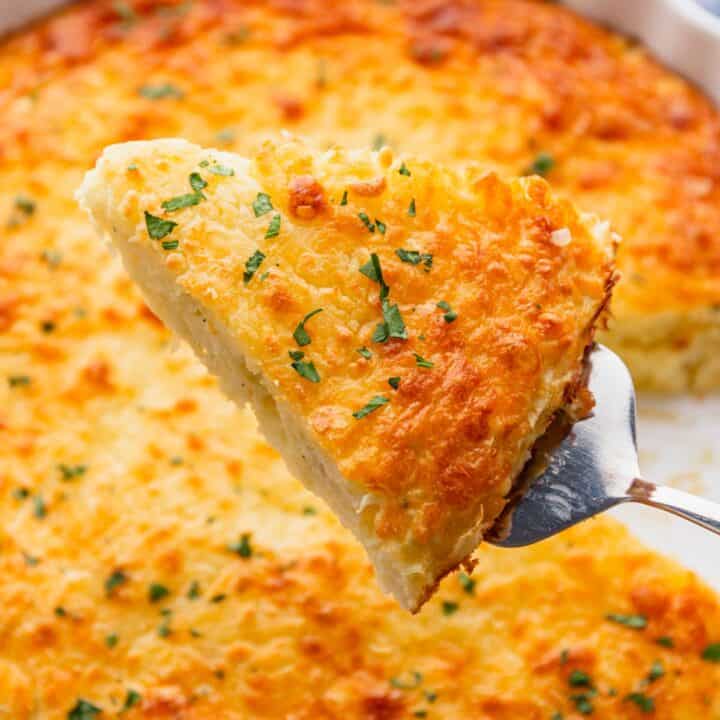



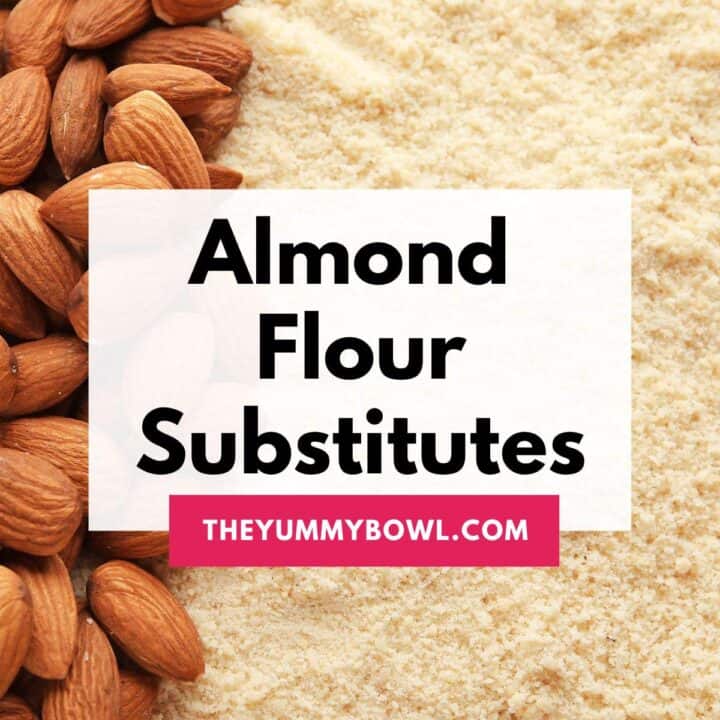
Comments
No Comments